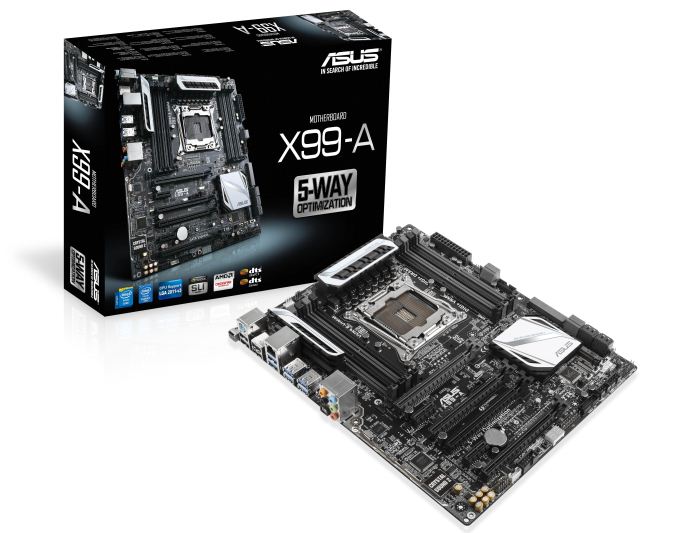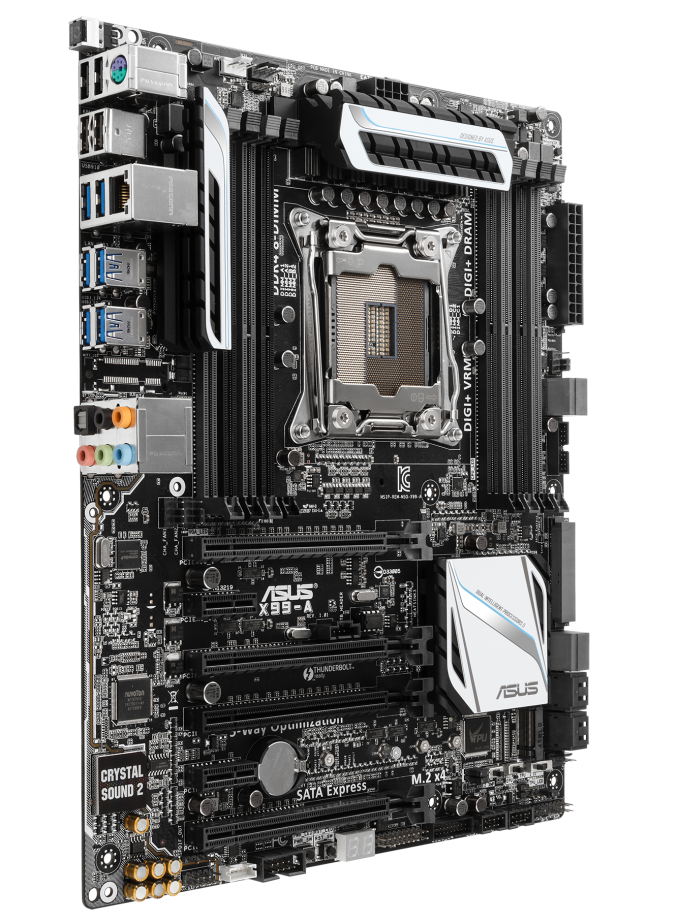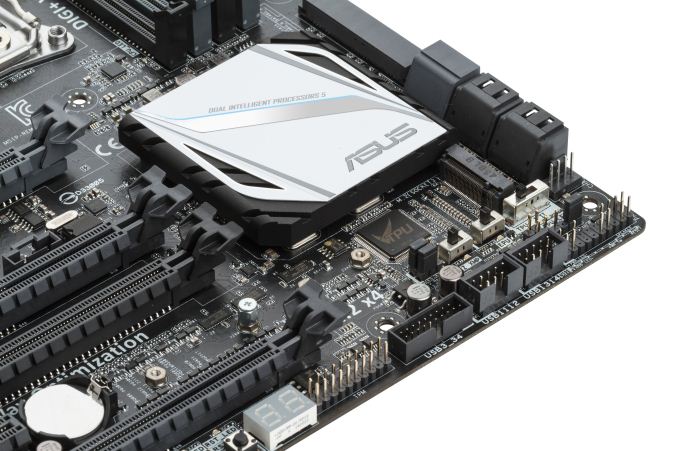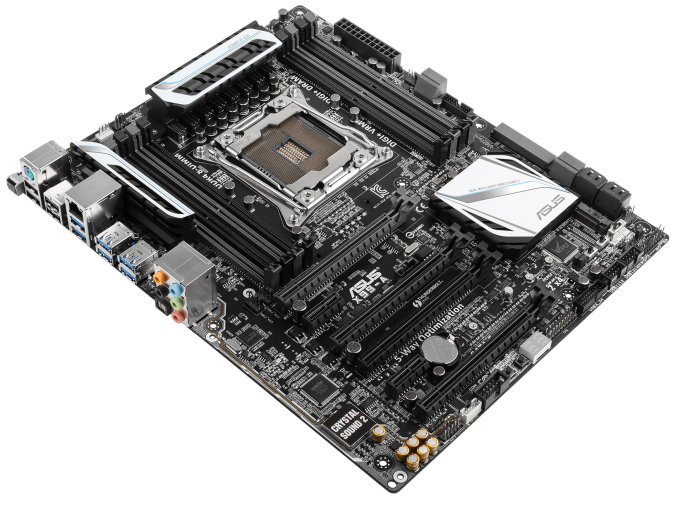ASUS X99-A Motherboard Review
by Ian Cutress on December 22, 2014 2:00 PM EST- Posted in
- Motherboards
- Intel
- Asus
- Haswell-E
- LGA2011-3

X99 and Haswell-E, due to the price, the performance and the feature set, ends up being very expensive compared to the mainstream. It is an odd state of affairs in the self-build arena when a reviewer states that the budget end of a spectrum is sub-$300. In this space we find the ASUS X99-A at $275 MSRP. This motherboard is the topic of our review today.
When considering the motherboard market as a whole, in all except in the server market, the $300 level usually represents the premium level marker. There are very few motherboards on the Z97 chipset that pass this barrier for example, and those that do are usually the cream of the crop. As a result, with Z97 the $250-$300+ range really aims for the higher mainstream performance and functionality. In X99, the $250-$300 level is the base. One of the reasons for this is that due to the prosumer nature of the market, where every motherboard has a lot of features which do not come cheap. There's very little demand for a stripped system outside of the OEM market.
So as a result, the budget end of the market for X99 is still feature packed, even with the X99-A. For comparison we reviewed the $400 ASUS X99-Deluxe when the chipset first launched, and it came with almost everything apart from the kitchen sink. The Deluxe was ASUS' main product for the X99 launch focus, and the X99-A arrived a few weeks later. At $275 it represents a cut down version of the Deluxe.
ASUS X99-A Overview
One new feature that crosses over from the Deluxe is the EZ XMP switch on the board, allowing users to apply their high speed memory profile without even touching the BIOS. My last trip to a LAN event resulted in anecdotal findings of high speed memory kits being used at JEDEC speeds, so something as simple as this should help let users get the most out of their memory.
For gaming or PCIe coprocessor use, this board is aimed at tri-GPU setups with a full PCIe 3.0 x16/x16/x8 layout. One potential benefit of this rather over focusing on full-bandwidth four-way arrangements is that the three-way version saves some build cost by avoiding the additional timing circuits needed for full bandwidth when using four cards. There is an additional PCIe 2.0 x4 slot from the PCH in the middle of the main PCIe slots for Thunderbolt or additional cards. This is situated as to not interfere with dual slot PCIe configurations.
As with most X99 boards there is full access to the 10 SATA ports from the PCH - six of which are RAID capable and the other four which are not as they are from the secondary AHCI controller. For good measure there is also a SATA Express port and a M.2 x4 Gen 3.0 port, with the SATA Express getting RST privileges. The SATA Express shares bandwidth with the PCIe 2.0 x4 slot whereas the M.2 is switched with the final PCIe slot. There are 10 USB 3.0 ports total which come as five from the PCH (two headers and a rear IO port), three from an ASMedia hub (rear panel) and two from an ASMedia controller (also rear panel). An interesting deviation in design is that the ASMedia ASM1074 hub used on the board is a 1-to-4 hub but only three ports are used. This is most likely due to the rear panel design, where a set of three USB ports doesn't really exist.
In terms of performance the system does not implement Multicore Turbo, meaning that stock performance is down compared to some other products but a simple click on the TPU switch avoids this with a small 3.9 GHz overclock. ASUS' strengths on X99 remain the audio performance, with the POST times and power consumption being ballpark for the chipset. ASUS also bundles in their BIOS and software combination which both hit the higher notes in terms of the competitors.
At the time I started writing this review the ASUS X99-A was only $240 at Newegg, making it a really nice price, however it has since gone back up to $275. The other X99 motherboard from this price range we have reviewed scored quite highly and the X99-A gives it a run for its money for sure.
Visual Inspection
Part of the initial appeal of the X99-Deluxe was the style in which it was presented – the white and silver livery gave it a streamlined look, and the protective cover over the rear IO and audio section of the motherboard added to that effect. The X99-A retains some of this styling, although it is limited in effect due to it only being on the three heatsinks. These heatsinks are also not joined to each other, which might reduce the effect of the aesthetic.
Nevertheless the motherboard itself feels a little busy, with lots of components having the white border around them for the SMT machines for placement. The socket area is fairly busy in that regard, and the CPU has access to five of the fan headers – two 4-pin CPU headers in the top right, two chassis headers to the bottom left of the DRAM slots near the rear panel, and another just below the 24-pin ATX header. The final fan header is below the SATA ports, with a FAN_EXT header for fan extension cards on the bottom of the board near the rear audio port. Each of these fans is 4-pin and can support PWM and DC fans.
Alongside the DRAM on the right hand side is the MemOK button, useful for recovering from failed POST due to memory issues. Beneath this is the 24-pin power connector and a fan header, followed by two of the SATA ports. These are RAID/RST compatible, along with the next four in grey, but the following four in black are not as they are from the secondary AHCI controller on the chipset. The middle two grey SATA ports are part of the SATA Express connector, and between all of these is one of the USB 3.0 headers.
In the chipset area of the board, below the heatsink is the M.2 x4 Gen 3.0 slot, supporting 2242 to 22110 sized drives. Underneath is our EZ XMP switch, EPU and two-stage TPU.
Along the bottom of the board, from right to left, is the front panel header, two USB 2.0 headers, a USB 3.0 header, a TPM header, the two-digit debug LED, power and reset buttons, a COM header, the fan extension header and the front panel audio.
The Crystal Sound 2 audio solution is an upgraded ALC1150 configuration featuring PCB separation, an EMI shield and filter caps for the front panel audio. Also in this area the PCIe arrangement gives a PCIe 3.0 x16, 2.0 x1, 2.0 x4, 3.0 x16, 2.0 x1 and a 3.0 x8. This gives x16/x16/x8 for GPUs when a 40-lane PCIe CPU is used, or x16/x8/x4 when a 28-lane CPU is used. Unfortunately that means that the i7-5820K will not be able to use three-way SLI. Also worth noting is that when the M.2 slot is in use, the final PCIe slot is disabled due to bandwidth switching.
The rear panel gives the USB BIOS Flashback button, a combination PS/2 port, four USB 2.0 ports, an Intel I218-V network port, six USB 3.0 ports and the audio jacks. The six USB ports are split such that those under the network port are from the controller, the next two to the right are from the hub, and the final two are split between one from the PCH and one from the hub.
Board Features
| ASUS X99-A | |
| Price | US (Newegg) |
| Size | ATX (305 x 244 mm) |
| CPU Interface | LGA2011-3 |
| Chipset | Intel X99 |
| Memory Slots | Eight DDR4 DIMM slots supporting up to 64 GB Up to Quad Channel, 2133-3200 MHz |
| Video Outputs | None |
| Network Connectivity | Intel I218-V |
| Onboard Audio | Realtek ALC1150 via Crystal Sound 2 |
| Expansion Slots | 2 x PCIe 3.0 x16 1 x PCIe 3.0 x8 1 x PCIe 2.0 x4 (default x1) 2 x PCIe 2.0 x1 |
| Onboard Storage | 6 x SATA 6 Gbps, RAID 0/1/5/10 4 x S_SATA 6 Gbps, no RAID 1 x SATA Express 1 x M.2 x4 Gen 3 for 2242 to 22110 |
| USB 3.0 | 2 x Headers for 4 Ports (PCH) 1 x Rear Panel Port (PCH) 2 x Rear Panel Ports (ASMedia controller) 3 x Rear Panel Ports (ASMedia hub) |
| Onboard | 10 x SATA 6 Gbps Ports 1 x SATA Express 1 x M.2 x4 Gen 3 6 x Fan Headers 2 x USB 3.0 Headers (PCH) 2 x USB 2.0 Headers Thunderbolt Header COM Header TPM Header EZ XMP Switch DirectKey Header MemOK Button Thermal Sensor Header TPU/EPU Switches Power/Reset Puttons Overvolt Header EXT_Fan Header SLI/CFX Switch Front Panel Header Front Audio Header |
| Power Connectors | 1 x 24-pin ATX 1 x 8-pin CPU |
| Fan Headers | 1 x CPU (4-pin) 1 x CPU_OPT (4-pin) 4 x CHA (4-pin) |
| IO Panel | USB BIOS Flashback Button Combination PS/2 Port Four USB 2.0 Ports Five USB 3.0 Ports via ASMedia One USB 3.0 Port via PCH Intel I218-V Network Port Audio Jacks via Realtek ALC1150 |
| Warranty Period | 3 Years |
| Product Page | Link |






















37 Comments
View All Comments
stambous - Friday, December 26, 2014 - link
"In terms of performance the system does not implement Multicore Turbo, meaning that stock performance is down compared to some other products but a simple click on the TPU switch avoids this with a small 3.9 GHz overclock".I can syncronise all cores for turbo in BIOS and when CPU is under load all 8cores works on 3,5GHZ in stock config without OC.
kenshinco - Monday, December 29, 2014 - link
...and how did you do it? What settings did you set?stambous - Friday, January 2, 2015 - link
Very simply go to Adavnce mode in BIOS.Then Ai tweaker menu.You will see there CPU core ratio select from auto to "sync all cores".And thats it from this point all eight cores always work under load at 3,5GHZ instead of standard Intel turbo.Dont forget set under CPU settings C states from auto to "enabled".This will downclock CPU when idle.You dont want have always in idle all cores at 3,5GHZ:-)
stambous - Friday, January 2, 2015 - link
And what is best when you have sync all cores you can under Windows on Ai suite set higher ratio to all ocres too and have overclocked all cores together.My CPU is stable at 3,7GHZ all cores synced with stock voltages.I can go further and higher but at higher freq 3,8+ i need put voltages higher which i dont want.Iam good with small moderate OC at 3,7GHZ for all cores with stock voltages and low temps.microline - Saturday, July 4, 2015 - link
Will this board support Windows r2 Server OS?Endre18 - Monday, July 20, 2015 - link
Hey!I just recently bought a Asus x99-A/3.1 and im wondering if i can connect a thunderbolt ex II card onto it?
from what i can read at the Asus homepage it is not compatible...
Thanks in advance!
Equinox--- - Thursday, August 20, 2015 - link
I´ve used this card in my new rig for a couple of months now together with i75820, and have Antec Kuhler watercooling, using it together with the new ASUS STRIX GTX980ti 6GB Gaming, and both gaming and other more demanding tasks, as photo editing etc, runs exceptionally smooth. I can´t really see the point in shelling out for a deluxe-version for maybe 100$ more, thinking that it will seriously outperform this card in most processes. Overclocking this is a joy, watercooling should certainly be used in that case.Highly recommended!